Hot weather is great for us, but can be a bother for lawns. Long periods of dry weather can lead to a drought, and though grass and grass seed is incredibly resilient, frost hardy, tolerant of close mowing, and robust enough to walk on, all while looking good all year round, it does need some extra TLC during this time to help its water levels.
This article will give you expert advice on how to care for your lawn during the summer months, and how to deal with a drought.
The grass is incredibly resilient. In fact, I can’t think of any other plant that we expect (and get) so much from. Could you say the same for flowers or vegetable plants?
So given that your lawn does all that whilst absorbing greenhouse gasses and providing you with oxygen, it’s only fair that you give it some TLC in return isn’t it?
During hot weather, your grass will be under a lot of stress. It will lose water from its leaves in a process called transpiration. Transpiration is great for people, as it’s what makes a natural grass lawn cool to sit on and it’s why a garden with a lush green lawn feels luxuriously fresh on a hot day.
Transpiration cools the plant but it does involve water exiting the leaves. That’s fine, provided that the plant can replace that lost water by sucking more up through its roots. When the soil is really dry, the plant can’t rehydrate itself and that’s when it goes into survival mode.
This is when you will need to come to the rescue to help your lawn last through the drought period.
Dealing with lawns and drought
When your lawn runs out of soil water it will go into survival mode. Any water and nutrients being held in the leaves will be moved and stored in the roots, where the underground temperature is cooler and there are no drying winds. This means that your lawn in hot weather will lose its green colour and its lovely texture to become brown, straw-like and parched.
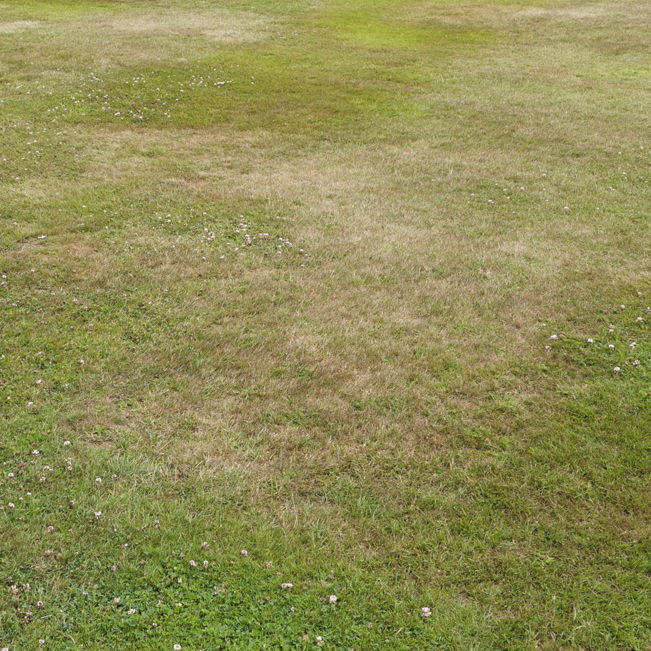
A large lawn in very dry weather. It’s not unusual for different grass species to react slightly differently to drought. Fescue grasses and bent grasses tend to turn brown sooner than the deeper-rooting ryegrasses. The clover in the foreground seems to be doing OK too. Dry weather will reveal many of your lawn’s hidden secrets!
What that means is that your lawn in hot weather will lose its green colour and its lovely texture to become brown, straw-like and well, parched.
At this point, you have two choices. You can either water your lawn, or you can work with nature and adapt your lawncare regime accordingly.
I’m not even going to discuss the first choice. Water is a scarce resource and as the UK population rises it’s more and more difficult for water companies to keep up with the job of cleaning and distributing our water. When there’s a drought, mains water should be used for health, hygiene and food production. Lawns are beautiful, I love them very much, but I know that a brown lawn will recover when it rains so I’m saving mains water for my early morning cuppa.
I won’t be watering my lawn in hot weather.
That just leaves plan B.
How to care for your lawn in hot weather or drought
- Keep off the grass as much as possible
- Move toys, rugs and furniture off the lawn
- Raise the blades on your lawnmower
- Allow lawn clippings to drop back into the sward
- Don’t apply lawn treatments during a drought
- In a wet summer, keep feeding the grass
- Plan your autumn lawn renovations – they’ll help your lawn to recover after the hot weather
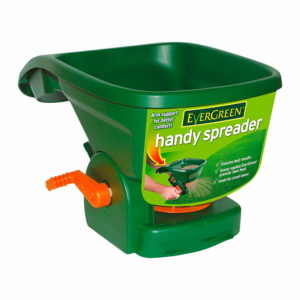 |
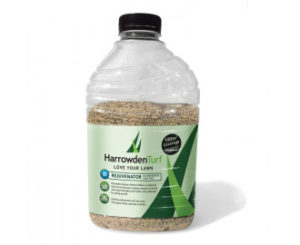 |
 |
 |
Keep off the grass as much as possible
I know it’s not always possible but if you can reduce the amount of wear and tear (stress) on your lawn, please do.
Don’t leave toys and furniture on the lawn for more than 48 hours.
Move stuff around. Encourage children and dogs to enjoy the weather without running around. And if you need to walk over the lawn to get to the shed/chicken run/washing line, try to take a different route each time.
Let the grass grow a bit longer than usual
You probably won’t need to mow the lawn. But if you do, keep the mower blades as high as possible and as sharp as possible. Longer grass shades the soil beneath it and slows down moisture loss. It creates a microclimate, a bit like a very small jungle.
Let the clippings drop back into the sward
They’ll form a mini-mulch, similar to the layer of bark chips that you spread beneath shrubs to conserve soil moisture.
Hold back on all lawn treatments in a drought
Do not use lawn feed or use weed killer during this time. At least not until it’s rained enough to turn the grass back to green again. Fertiliser is vital for the moisture control functions of the plant but should only be used whilst there is still adequate ground moisture within the soil. If your soil is completely dry, it is pointless to fertilise a dry lawn.
If it does rain, apply a spring-summer lawn feed to help your lawn build the root system it needs to see it through the hot weather.
If it rains – top up your lawn feed
Apply a spring- summer lawn feed to help your lawn build the root system it needs to see it through the hot weather.
Prepare for autumn
Once the rain has come and your lawn is looking green, plan your autumn renovations. Aeration, scarification and topdressing will all help improve the soil beneath your lawn so that it retains water for longer next time there’s a drought.
Looking after newly laid turf in a drought
Newly laid turf needs much more TLC than an established lawn because it doesn’t have a strong enough root system to support the plants’ survival mode.
If you can delay turfing until the drought has passed, please do so. If not, then you need to be super-vigilant overwatering.
If its essential that you lay your new lawn in hot weather, add some water retaining gel crystals to the soil before you lay your turf. It will help you to ensure that as little water as possible is lost to evaporation.
Water in the early morning or late evening – both if you need to. When the sun is lower in the sky water has more chance of sinking into the soil before it evaporates away in the heat of the sun.
If your area is subject to a hosepipe ban, talk to your water authority. You may be able to get a temporary exemption. If not, you’ll be getting lots of exercises as you irrigate your new turf with a watering can!
Related information
Why a natural lawn is better than artificial turf – whatever the weather
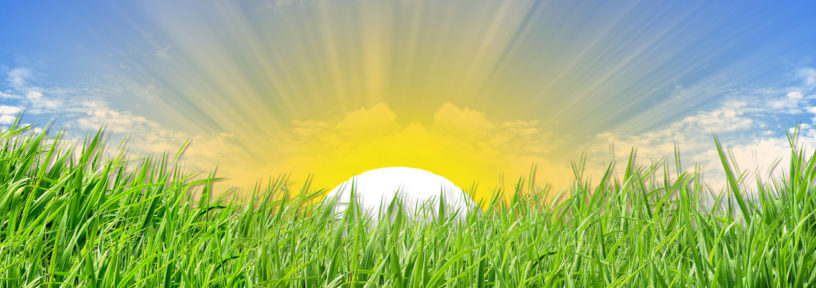
 How to lay turf in hot weather
How to lay turf in hot weather 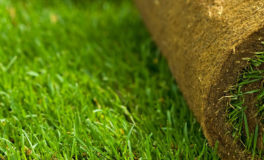 Hot weather reduces turf shelf life dramatically
Hot weather reduces turf shelf life dramatically 

